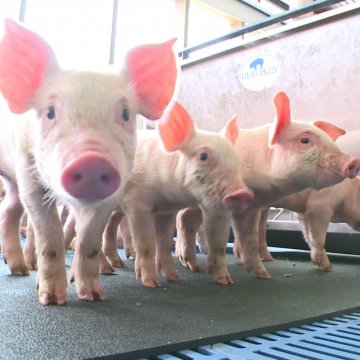Last year, the American Farm Bureau Federation (AFBF) and National Pork Producers Council (NPPC)...
Fewer Hog Farms, But Far More Hogs Per Farm

In the space of a generation, U.S. hog production has transformed, even in the Midwest, with Iowa still the leader, according to a new USDA Hogs and Pigs report. There were half as many hog farms in the country in 2017 as there were in 1997, and the largest farms, often highly specialized operations, raising 93% of the pigs.
The shift to specialized operations occurred along with two other developments: The movement to widespread use of production contracts and the emergence of larger operations. By capturing economies of scale, large hog operations have become more efficient than smaller ones.
The largest farms, with more than 2,000 head, held 61% of U.S. hogs in 1997. Their share grew to 91% in 2017, although they were one-eighth of the 66,439 hog farms in the nation.
Traditionally, hogs were raised on the same farm from birth until they were ready for slaughter. Such farrow-to-finish operations accounted for 54% of hog farms and 65% of hog production in 1992. They have been displaced by feeder-to-finish operations, which specialize in the final stage of fattening market hogs for slaughter. By 2015, 60% of hog farms were feeder-to-finish operations, producing 83% of all hogs.
Hog production was concentrated in the Midwest for most of the 20th century, and USDA’s latest Hogs and Pigs report says the region is home to two-thirds of all hogs. Iowa is the number 1 hog state, producing nearly one-third of the total; Minnesota is number 2 with 12%. Since the 1990s, production expanded in the Southeast, and North Carolina is the number 3 state with 11%.
Familiarity with poultry contract production in the Southern Seaboard Region likely contributed to the acceptance of contracts for hog production in North Carolina, according to the report. All but a few hog farmers were independent operators in 1992. By 2015, 53% of farms raised hogs under contract and they produced 69% of the hogs. Production contracts were dominant in North Carolina, accounting for 91% of its hogs sold in 2017. Iowa and Minnesota were split between independent and contract production.
Hogs reach slaughter weight about six months after birth. The U.S. pig herd has grown in number by 18% since 1997, and market hogs weighed an additional 33 pounds per head in 2017. Those two factors — more hogs and larger hogs — contributed to an increased supply of U.S. pork. Hog sales or removals per farm averaged 945 in 1997 and were nine times larger, 8,721 head, in 2015.
Per capita consumption of pork has been stable, so exports have become an important market. Nearly a quarter of the estimated 27.1 billion pounds of pork produced this year will be sold overseas.
The hog sector began a major transformation in the early 1990s and since then has experienced productivity growth, structural change, increased output and expanded exports. From a broad perspective, the number of hog farms have declined over time, the typical farm became larger and the regional pattern of production shifted.
The USDA report on Hogs and Pigs is available here.
Editor’s Take:
Your AIR Editor loved raising hogs back in the day. Growing up on a diversified farm with crops, dairy, hogs and poultry was always a challenge. Every species or crop demanded that you know a good deal about each enterprise. This latest USDA report on hog and pig production demonstrates just how much things have changed over time.
Today’s modern production practices allow for the concentration of time and effort on one species. This type of focus also offers major production efficiencies that were not possible with diversified production. Marketing has been simplified through the use of futures contracts to hedge inputs and outputs, or the use of production contracts, directly with major packing houses/buyers. The change in production regions is also notable in this latest report.
All in all, the changes have been positive. However, the spread of diseases, such as African Swine Fever, can be devastating in highly concentrated operations. Also, new producers face a bigger challenge getting started and building scale, but that can be partially offset by contract production and pricing.
Hog production is a vibrant and ever-changing business. These producers use a lot of trucks! Make sure you identify them in your market area and let them know about all you have to offer as a CAD member that is way over and above any non-CAD competitor!








